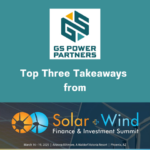Three Takeaways On The Renewables Industry From Infocast 2025

April 7, 2025
by Lori Arndt, CSO
Despite increased uncertainty around renewables and across the industry, the atmosphere at Infocast’s Solar + Wind Finance & Investment Summit last month was very positive. The GS Power Partners team was excited to take part at this year’s event as a sponsor. We met with so many influencers across the renewables value chain, engaging in interesting conversations about the state of the industry, access to capital, and the ways in which our industry is helping to meet increasing power demand.
During the event, our President, Nick Sangermano, took part in a panel titled “Inflation and Interest Rates: A Macro Look at Financing and LCOE in Today’s Economy.” Nick was joined on-stage by other industry experts to discuss topics such as the rising cost of capital, the surge in PPA pricing, supply chain issues, inflation, and other challenges to the industry. But despite the challenges, Nick and his panelists were bullish on renewables, which is in line with the general theme and tone of the conversations we participated in at the event.
Here are three key takeaways our team brought home from the conference:
Renewables Are Essential to American Innovation
Regardless of the differences between the current and previous administrations’ approach to renewables, one thing remains clear – energy has become more important to national security than ever before. Between the rise of data centers and the proliferation of electrification, energy demand is now exceeding even the most ambitious predictions. The International Energy Agency reported that global electricity consumption increased by 4.3% in 2024, nearly double the annual average over the past decade.
Solar is Needed to Meet Energy Demand
The use of renewables are essential to help meet this demand. While oil and gas continue to play an important role in fulfilling American electricity needs, there simply isn’t enough time to deploy new nuclear power, natural gas, and emerging technologies at the pace required. Gas companies have admitted that the supply chain will not allow for additional construction of gas turbines beyond those already planned through 2030. Solar projects, on the other hand, are far less expensive; from project approval to commercial operations, they are also much faster to install. With a robust domestic industry, solar is well-suited to scale up and meet immediate domestic electricity needs.
Distributed generation (DG) is an integral part of the solution to meet our modern energy needs. While solar is projected to make up over 50% of new U.S. generation capacity in 2025, nearly 10% of new generation capacity currently comes from DG solar. DG projects are nimble, quick to permit, construct, and interconnect, with significantly less delays than utility-scale solar.
Industry Collaboration is More Vital Than Ever
Given the ongoing supply chain constraints, the impact of tariffs, and high capital costs, project development is more challenging than ever, but developers remain optimistic. As an industry, we are entering an era of collaboration. Developers of all sizes are forming unique relationships with financiers, suppliers, and each other to overcome roadblocks. Industry veterans are leveraging the lessons learned over the past two decades of solar deployment to build out a resilient, cost-effective, and efficient pipeline of solar assets.
Solar (and storage) are key building blocks to ensuring a resilient electrical grid and setting the stage for American energy dominance. The renewables industry is more than ready to ramp up the deployment of affordable, reliable power across the country. At GS Power Partners, we are committed to achieving that mission.
